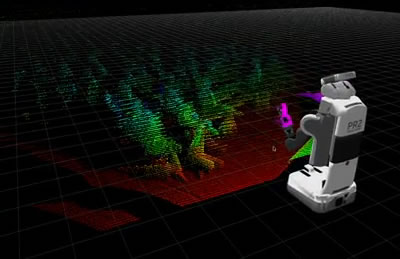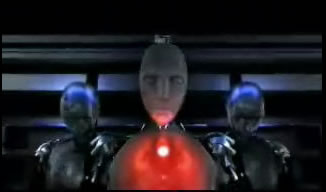Science Fiction
Dictionary
A B C D E F G H I J K L M N O P Q R S T U V W X Y Z
Google IO Cloud Robotics With PR2 Robot From Willow Garage

Cloud robotics makes use of cloud services to expand the capabilities of robots. Robots can make use of mapping and navigation services that already exist in the cloud; they can also make use of voice and text recognition services. Generally speaking, small and compact robots can make use of unlimited processing power in the cloud. Note that computing power is very power intensive; you can double the battery life of PR2 by removing one of its two computers, and doing the computation in the cloud.
Smarter robots, thanks to services already existent in the cloud.
The video stars the PR2 robot from Willow Garage; it shows updates to an earlier story PR2 Laundry-Folding Robot, demonstrating a significant increase in folding speed thanks to the cloud. More recently, the doughty PR2 robot wandered 100 km autonomously.
Check out this picture of PR2 using laser sensor data uploaded to the cloud to create a picture of the audience at Google IO.

(PR2 robot laser sensing)
Learn more in this video from Google IO 2011: be sure to take a look at the robotic cloud learning demonstration at 33:00, in which robots are taught to recognize objects quickly using cell phone pictures. If one robot learns to recognize an object, within a few minutes, they can all recognize that object - thanks to the cloud.
(Google cloud robotics talk at Google IO 2011)
Science fiction fans may recall that in the 2004 movie I, Robot, the most advanced robots, the NS5's, had a special feature: additional software and instructions could be downloaded wirelessly to individual robots. NS5's receiving a download show a red glow in the chest cavity.

(Middle NS5 Robot Gets A Download)
Scroll down for more stories in the same category. (Story submitted 5/19/2011)
Follow this kind of news @Technovelgy.| Email | RSS | Blog It | Stumble | del.icio.us | Digg | Reddit |
Would
you like to contribute a story tip?
It's easy:
Get the URL of the story, and the related sf author, and add
it here.
Comment/Join discussion ( 1 )
Related News Stories - (" Robotics ")
Mornine Sales Robot
'Robot-salesmen were everywhere, gesturing...' - Philip K Dick, 1954.
Bipedal Robot Floats Gently While Walking
'a walking balloon proceeded with long strides of its aluminum legs...' - George Parsons Lathrup, 1897.
YES!! Remote Teleoperated Robots predicted by Technovelgy!
'...a misshapen, many-tentacled thing about twice the size of a man.'
Will Robots Ever Fold Landry?
Where have you gone, Mrs. Robinson?
Technovelgy (that's tech-novel-gee!) is devoted to the creative science inventions and ideas of sf authors. Look for the Invention Category that interests you, the Glossary, the Invention Timeline, or see what's New.
Science Fiction
Timeline
1600-1899
1900-1939
1940's 1950's
1960's 1970's
1980's 1990's
2000's 2010's
Current News
iPhone Air Fulfils Jobs' Promise From 2007 - A Giant Screen!
'... oblongs were all over the floor and surfaces.'
ChatGPT Now Participates in Group Chats
'...the city was their laboratory in human psychology.'
iPhone Pocket All Sold Out!
'A long, strong, slender net...'
Did The Yautja Have These First?
What a marvel of ingenuity the little device was!
Jetson ONE Air Races Begin, Can Air Polo Be Far Behind?
'If you're one of those rarities who haven't attended a rocket-polo "carnage", let me tell you it's a colorful affair.'
Will Space Stations Have Large Interior Spaces Again?
'They filed clumsily into the battleroom, like children in a swimming pool for the first time, clinging to the handholds along the side.'
Mornine Sales Robot
'Robot-salesmen were everywhere, gesturing...'
Bipedal Robot Floats Gently While Walking
'a walking balloon proceeded with long strides of its aluminum legs...'
Musk Idea Of Cars Talking To Each Other Predicted 70 Years Ago
'My cars talk to one another.'
Elegant Bivouac Shelter Produces Water And Electricity
'There was nowhere on the planet where science and technology could not provide one with a comfortable home...'
X-Control Janus-1 A Suitcase Aircraft
'You will notice that it... fits the suitcase nicely.'
'AI Assistants' Are Actually Less Reliable For News
'Most men updated their PIP on New Year's Day...'
YES!! Remote Teleoperated Robots predicted by Technovelgy!
'...a misshapen, many-tentacled thing about twice the size of a man.'
Will Robots Ever Fold Landry?
Where have you gone, Mrs. Robinson?
Will AIs Give Better Results If You're Rude To Them?
'I said, "Listen up, motherf*cker.'
Cybertruck Robotic Arm F10 Drone Launch!
Drone away!
